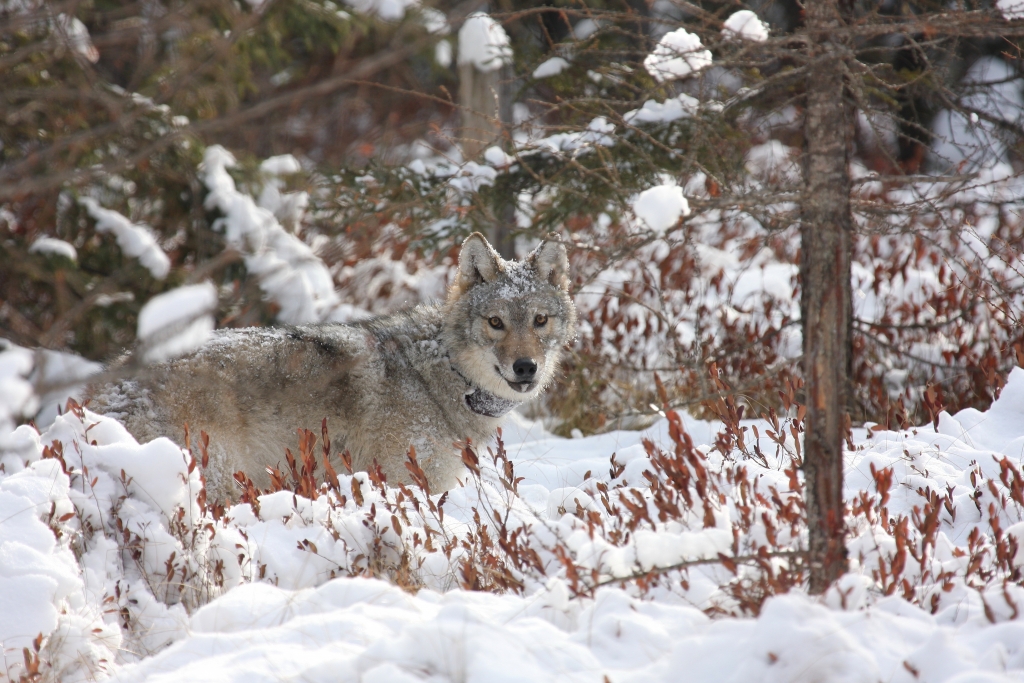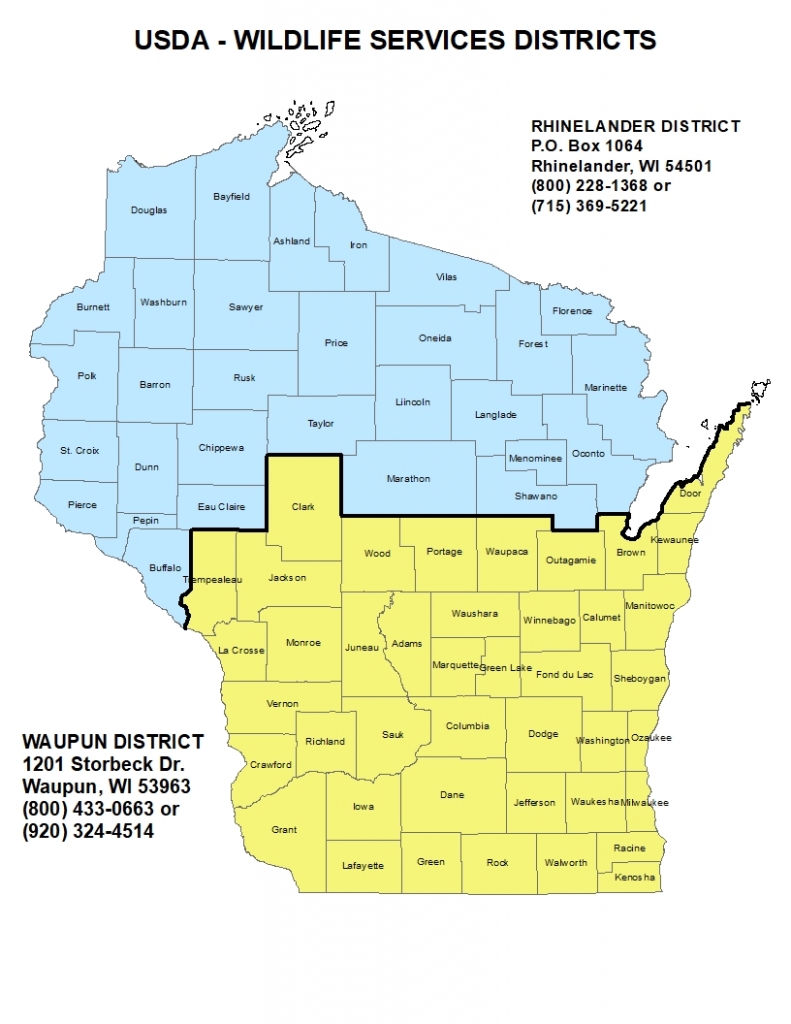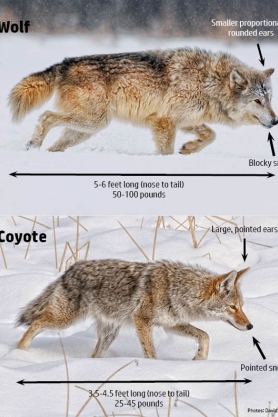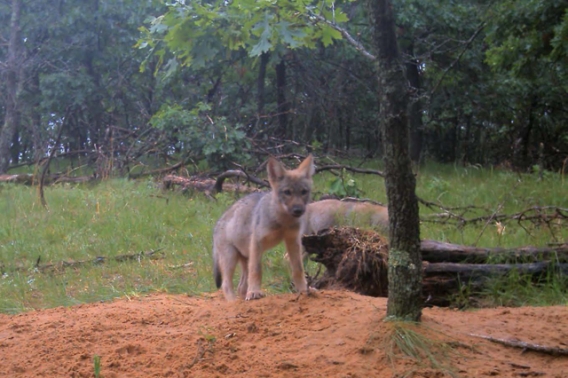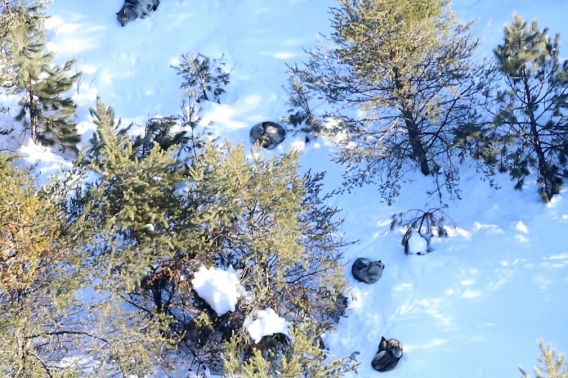Wolves in Wisconsin
What's New
Following a federal court ruling on Feb. 10, 2022, gray wolves are listed as an endangered species in the lower 48 states (excluding the northern Rocky Mountains region). As such, wolves are federally protected. Harvest and lethal depredation control are prohibited.
Wisconsin's wolf population remains healthy and secure in the state. The department will continue its robust wolf population monitoring program and the implementation of the Wisconsin Wolf Management Plan 2023.
The DNR will continue to partner with USDA-Wildlife Services to address wolf conflicts in Wisconsin. If you suspect wolves in the depredation of livestock, pets or hunting dogs, or if wolves are exhibiting threatening or dangerous behavior, contact USDA-Wildlife Services staff immediately. If in northern Wisconsin, call 1-800-228-1368 or 715-369-5221; in southern Wisconsin, call 1-800-433-0663 or 920-324-4514. While gray wolves are listed as a federally endangered species, it remains unlawful to shoot a wolf unless there is an immediate threat to human safety.
2024–2025 Wolf Monitoring Report Available
Read the 2024-2025 Wolf Monitoring Report. Previous year's reports can be located under the "Reports" tab.
Information For Volunteer Trackers
Trackers can find survey materials and maps under the "Wolf Monitoring" section below and within the "Volunteer Tracking Program" section. Any questions about the tracking program can be directed to Danielle Deming, DNR assistant wolf specialist, at Danielle.Deming@wisconsin.gov.
Frequently Asked Questions (FAQs)
How many wolves are there in Wisconsin? Where do they live?
Scroll down to find a general overview of wolf numbers and ranges in the state. You can also find more details in our annual wolf monitoring report above or further down the page under the "Population Monitoring Reports" section.
Did the DNR release wolves into Wisconsin?
No. Unlike the famous wolf reintroductions in Yellowstone National Park, humans never released wolves into Wisconsin. After wolves were given protection under the federal Endangered Species Act, existing wolf populations in northern Minnesota rebounded and naturally expanded their range into northern Wisconsin.
Are wolves native to Wisconsin?
Yes. It's estimated that there may have been 3,000-5,000 wolves in Wisconsin before European settlement. For more information on the history of wolves, check out the "Wolves in Wisconsin" tab above.
How big are wolves? What do they eat?
For an overview of wolf biology, including diet, check out the "Biology" tab above.
Do wolves reduce deer numbers?
The relationship between wolves and deer is complex. Generally, winter weather and human harvest, especially antlerless harvest, have more significant impacts on deer populations than predation over the long term. Deer herds in northern Wisconsin have remained strong, even with an established wolf population, suggesting that wolves have not limited deer population growth. However, deer may alter their behavior, movements and/or habitat use in response to the presence of wolves.
Wolves are skilled at identifying vulnerable prey and tend to target old, young, sick or otherwise weakened individuals. Hence, deer removed by wolves are less likely to survive and less likely to produce offspring than the deer that remain. The average age of white-tailed deer killed by wolves was 6.5 years in Minnesota, for example, whereas the average age of does taken by hunters was 2.5 years in this same area. This targeting of vulnerable animals serves to reduce the impact of wolves on long-term deer population dynamics. It has also been suggested that wolves might reduce CWD transmission rates and prevalence by removing sick individuals.
An interesting and more detailed article on the relationship between deer hunting and wolves was published by a Minnesota biologist in 2009.
Are wolves dangerous to people?
Just like any wild animal, wolves tend to avoid humans. Verified cases of healthy wolves attacking humans are extremely rare, and there have been no documented cases in Wisconsin.
Most incidents of wolf aggression toward people have involved wolves that have become habituated to people or involved domestic dogs. To avoid wolves becoming habituated to people, it is important to never feed or approach wolves in the wild. For more information on living with wolves as neighbors, please see the "Living With Wolves" document under the "Wolf Conflicts" section below.
What should I do if I encounter a wolf?
Wolves generally avoid people and rarely pose a threat to human safety. However, if you encounter a wolf, do not approach, feed, or attempt to interact with the wolf in any way. By taking these steps, it will generally move away on its own. If the wolf does not move off on its own, do not run, as this may initiate a chase response by the wolf. Try to maintain eye contact with the wolf, act aggressively, shout and back away slowly.
How can I keep my pet safe?
Attacks on dogs in residential areas represent a special kind of wolf depredation to domestic animals. These conflicts remain relatively uncommon, but unfortunately, several incidents do occur every year.
If you live near wolves, avoid outside bathroom breaks for your dog after dark. If you need to let it out after dark, put bright lights on and make noise. Ensure your dog is trained to avoid chasing or approaching wild animals and can return on command.
- Do not leave pets outside overnight unless they have a sturdy kennel.
- Avoid feeding deer near your home.
- Don't leave cat or dog feed outside at night.
- Don't deposit table scraps or animal products near home sites.
- Keep pets on a leash or in visual/auditory range on walks and vocalize regularly, including the use of whistles.
- Don't allow dogs to roam at large.
Can I shoot a wolf to protect my livestock or pet?
No. Wolves are listed as federally endangered in Wisconsin and may only be killed in defense of human life.
If you suspect wolves in the depredation of livestock or pets, or if wolves exhibit threatening or dangerous behavior, please get in touch with USDA-Wildlife Services staff from one of the numbers below. For more information on dealing with nuisance wolf issues, check out the "Wolf Conflicts" section below.
Wolves In Wisconsin
Wolves Today
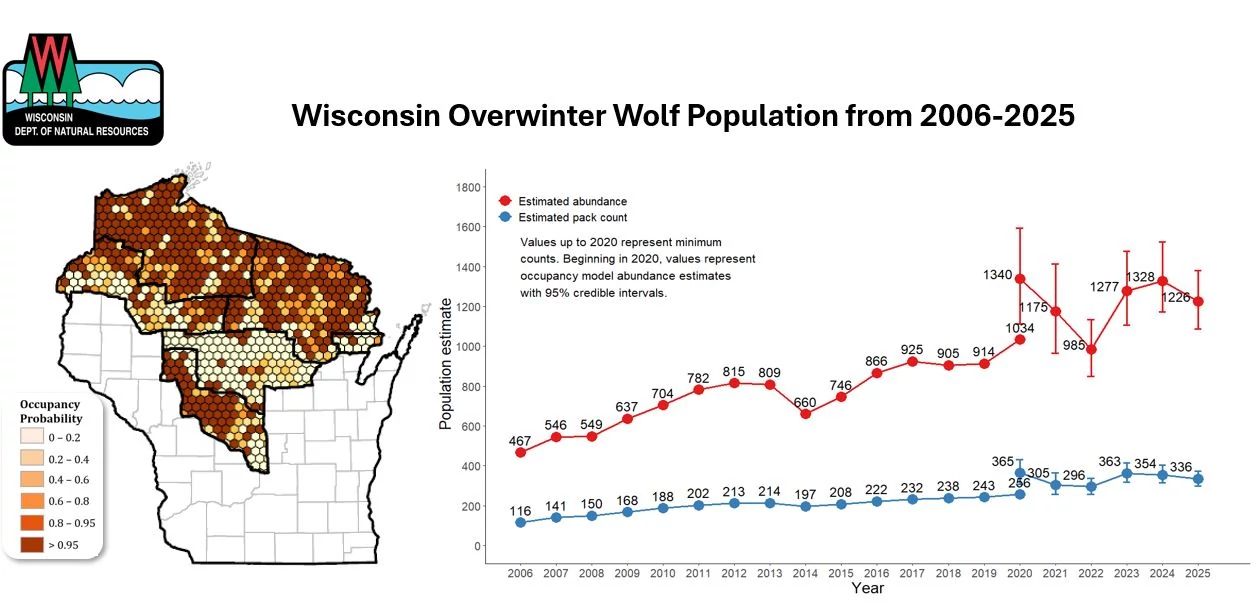
During the 2024-2025 overwintering period, the number of pack-associated wolves was estimated between 1,087 and 1,379 within the pack-occupied range, with the most likely estimate being 1,226 wolves. The total number of packs was estimated to be between 299 and 373 packs, with a most likely value of 336 packs. Wolf monitoring is conducted every winter when snow cover allows efficient tracking, representing the low point in the annual wolf population cycle. Wolf numbers increase each year following the spring breeding period. The 2024-2025 Wolf Monitoring Report is available under the "Reports" tab above.
The increase in wolf numbers over the past 30 years has generally been accompanied by range expansion within the state. In portions of the northern and central forest, where wolves have been established for many years, territorial behavior has kept wolf numbers fairly stable. In recent years, range expansion across the state has been minimal, suggesting that wolves likely occupy all suitable habitats in Wisconsin.
History Of Wolves In Wisconsin
Pre-management
Before European settlement, 3,000-5,000 wolves were believed to have been found throughout Wisconsin. During the 1800s, unregulated hunting by settlers extirpated bison, elk, caribous and moose in the state and nearly eliminated white-tailed deer.
As prey species became scarce, wolves increasingly began to feed on livestock. This led the state legislature to pass a bounty on wolves in 1865. The state bounty on wolves persisted until 1957 when the state classified wolves as a protected species. Elimination of bounties, however, made little difference for wolves as they had already been exterminated across most of Wisconsin. By the 1950s, only a few wolves remained in the far northern part of the state.
Protection
As a result of habitat loss, declines in prey populations and unregulated harvest, wolf populations declined until the species was declared extirpated from Wisconsin in 1960. Wide-spread declines among wildlife species eventually led to greater public scrutiny of unregulated harvests and increased support for conservation measures. The culmination of this changing ethic was the passage of the Endangered Species Act in 1973, which enacted significant protections for species at risk of extinction. In 1974, the federal government recognized the value of gray wolves via their inclusion on the list of endangered species.
Recovery: Back from the brink
After federal protections were established for wolves, the wolf population in Minnesota began to increase and expand its range. In the mid to late 1970s, this expansion led to wolves naturally recolonizing northwest Wisconsin and the first breeding pack was confirmed in Douglas County in 1978.
While initial population growth was slow, by the mid-1990s, Wisconsin's wolf population began to increase and expand steadily. Wolves in the Western Great Lakes region surpassed federal recovery goals in the winter of 1999-2000, when Wisconsin and Michigan had a combined total of 100 wolves for five consecutive years, and the population in Minnesota remained stable or continued to grow.
Wolves would not be able to thrive if it were not for the support of the people who live near them every day. Thankfully, studies show that Wisconsinites generally value and are in favor of wolves (Public Opinions Regarding Wolves 2022)
Wolf Management In Wisconsin
The recovery of wolves in the Western Great Lakes region stands as a testament to the cooperation of federal, state and tribal agencies, as well as other conservation partners working together to support wolf recovery. When evaluating the history of wolf management in Wisconsin, it is important to understand that conservation decisions are made at both federal and state levels, though federal law supersedes state law.
Federal Classification
Wolves in the Western Great Lakes region surpassed federal recovery goals in the winter of 1999-2000, when Wisconsin and Michigan had a combined total of 100 wolves for five consecutive years, in addition to the population in Minnesota being stable or growing (Wolf Recovery Plan).
However, the federal status of wolves has changed several times over the past two decades. The US Fish and Wildlife Service recently removed gray wolves from the federal endangered species list on Jan. 4, 2021. As of Feb. 10, 2022, the U.S. Fish and Wildlife Service relisted gray wolves as a federally endangered species.
State Classification & Management
As Wisconsin's wolf population met and exceeded recovery goals in the 1990s, biologists recognized the need to develop a state-driven approach to management that would support a healthy and persistent wolf population and identified goals for wolf management in the state. DNR staff worked closely with partners to develop the 1999 Wisconsin Wolf Management Plan and later added an addendum in 2007. This document has successfully guided recovery efforts for many years.
From 2021 to 2023, the Wisconsin DNR Wolf Management Plan committee updated our state's wolf management plan. During the plan update process, the DNR collected extensive public input through a wolf management plan committee and worked closely with our tribal partners and other natural resource professionals involved in wolf management in Wisconsin. The 2023 Wisconsin Wolf Management Plan was finally published in Fall 2023.
Wolf Biology
Taxonomy & Physical Description
Gray wolves (Canis lupus), also called timber wolves, are the largest wild members of the canid (dog) family. Their close relatives, coyotes (Canis latrans), are sometimes called brush wolves but are not true wolves. Wolves in Wisconsin can weigh between 50-100 pounds. Males tend to be larger than females, averaging 75 and 60 pounds, respectively.
Wolves have many color variations but tend to be buff-colored tans grizzled with gray and black (although they can also be black or white). In winter, their fur becomes darker on the neck, shoulders and rump. Their ears are rounded and relatively short, and the muzzle is large and blocky. Wolves generally hold their tail straight out from their body or point them downward.
Identification
Diet
Wolves are primarily carnivorous. A study in the early 1980s showed that Wisconsin wolves' diet comprised 55% white-tailed deer, 16% beavers, 10% snowshoe hares and 19% other small game (mice, squirrels, muskrats, etc.). Deer comprise over 80% of a wolf's diet throughout the year, but beavers become more important during the spring and fall when beavers are dispersing and spend more time on land, making them more vulnerable and easier to catch.
In the winter, when beavers are in their lodges or are moving safely beneath the ice, wolves rely more heavily on deer and hares. Wolves' summer diets are more diverse, including a greater variety of small mammals. Studies also show that berries can comprise over half of a wolf's diet during mid-summer.
Breeding Behavior
Wolves reach sexual maturity when they are two years old but seldom breed until they are older. Typically, the dominant pair in each pack breeds. Thus, a pack generally only produces one litter each year, averaging five to six pups.
In Wisconsin, wolves breed in late winter (late January and February). The female delivers the pups two months later in a den she digs but may sometimes choose a hollow log or abandoned beaver den instead. Wolf pups are born deaf and blind and weigh about 1 pound. They grow rapidly during the first three months, gaining about 3 pounds each week. Pups begin to see when they are two weeks old and can hear after three weeks. At this time, they become very active and playful.
Wolf pups at a den site. When about six weeks old, the pups are weaned, and the adults begin to bring them meat. Adults eat the meat at a kill site, often miles away from the pups, and then return to regurgitate the food for the pups to eat. The hungry pups jump and nip at the adults' muzzles to stimulate regurgitation.
The pack abandons the den when the pups are six to eight weeks old. The female carries the pups in her mouth to the first of a series of rendezvous sites or nursery areas. These sites are the focus of the pack's social activities for the summer months and are usually near water.
By August, the pups wander up to two to three miles from the rendezvous sites and use them less often. The pack abandons the sites in September or October, and the pups, now almost full-grown, follow the adults.
Pack Behavior
An aerial photo of a Wisconsin wolf pack. Wolves are social animals living in a family group or pack. In summer, a Wisconsin pack usually consists of six to ten animals -- a breeding pair, pups from the previous year (yearlings) and the current year's pups. Throughout the summer and fall, mortality and dispersal remove wolves from packs, so the average pack size declines. In Wisconsin, the average pack size is remarkably consistent across winters at around four wolves per pack. The breeding pair is in charge of the pack, raising the young, selecting denning and rendezvous sites, locating and capturing prey and maintaining and defending their territory.
A non-breeding wolf can attain breeding status by either staying with its natal pack and biding its time until it can attain a breeding position within the pack, or it can disperse to try and locate a mate and establish its pack in the vacant territory. Both strategies involve risk; a bidder may be out-competed by another wolf and never achieve dominance. Dispersers risk traveling great distances, as shown in the Wolf Disperse Animation video.
A pack's territory may cover 20-120 square miles, but the average territory size in Wisconsin is approximately 60 square miles. Neighboring wolf packs may share a common border, but their territories seldom overlap more than a mile. A wolf that trespasses into another pack's territory risks being killed by that pack. Wolves mark their territory boundary with urine and feces. Howling also helps a pack alert other wolves to their presence and is used to identify and reunite pack mates that may become separated within their large territory.
Wolf Monitoring
Program Overview
The DNR monitors the wolf population year-round using a combination of methods:
- Winter track surveys: DNR staff, trained volunteers, and other agency collaborators conduct winter snow track surveys in areas with known or suspected wolf packs to collect data on wolf packs and numbers. Historically, this information was used to estimate a minimum number of wolves in the state and was critical for monitoring progress toward population recovery goals.
- Occupancy modeling: Since 2020, DNR staff have employed a statistical modeling approach known as scaled occupancy modeling to estimate the abundance of pack-associated wolves in the pack-occupied range. This method uses data collected during winter track surveys along with information from GPS-collared wolves to estimate the total area occupied by wolf packs and the corresponding population estimate. This methodology is based on techniques widely used by the scientific community to monitor wildlife populations. It is similar to methods being used by other state agencies to estimate their wolf populations. Our model was developed in Wisconsin and has shown to be an accurate and efficient way to monitor our wolf population.
- GPS collars: Data from collared wolves allow biologists to estimate wolf pack territory size and improve our understanding of wolf movements. Long-term, these data also allow estimates of wolf survival.
- Public observations: Reported wolf observations by the public, especially outside areas currently occupied by wolves, help biologists identify packs in "new" parts of the state and better define wolf distribution.
- Depredations & wolf mortalities: Biologists monitor wolf depredations of livestock, pets, hunting dogs, and wolves found dead. This information contributes to our understanding of wolf distribution in the state.
Volunteer Tracking Program
Carnivores are often secretive and occupy very large home ranges, making monitoring them by direct observation difficult. However, we can still estimate the abundance and distribution of carnivores by observing the number and location of their tracks. In 1979, the DNR began conducting formal wolf track surveys as part of the state wolf monitoring program, and volunteers have contributed to these surveys since 1995.
Survey Blocks
The state has been divided into survey blocks where wolves and other carnivores are likely to occur. There may be a block in your area or where you often visit.
Each trained tracker is assigned a survey block of about 200 square miles. The survey block is designated by a system of roads or natural boundaries such as lakes and rivers. The tracker is responsible for surveying the different land cover areas (i.e. forested, agriculture, etc.) of their block for carnivores. Surveys are conducted by slowly driving the survey block one to three days after a fresh snowfall. All recent sets of tracks of medium and large forest carnivores are recorded along these snow-covered roads.
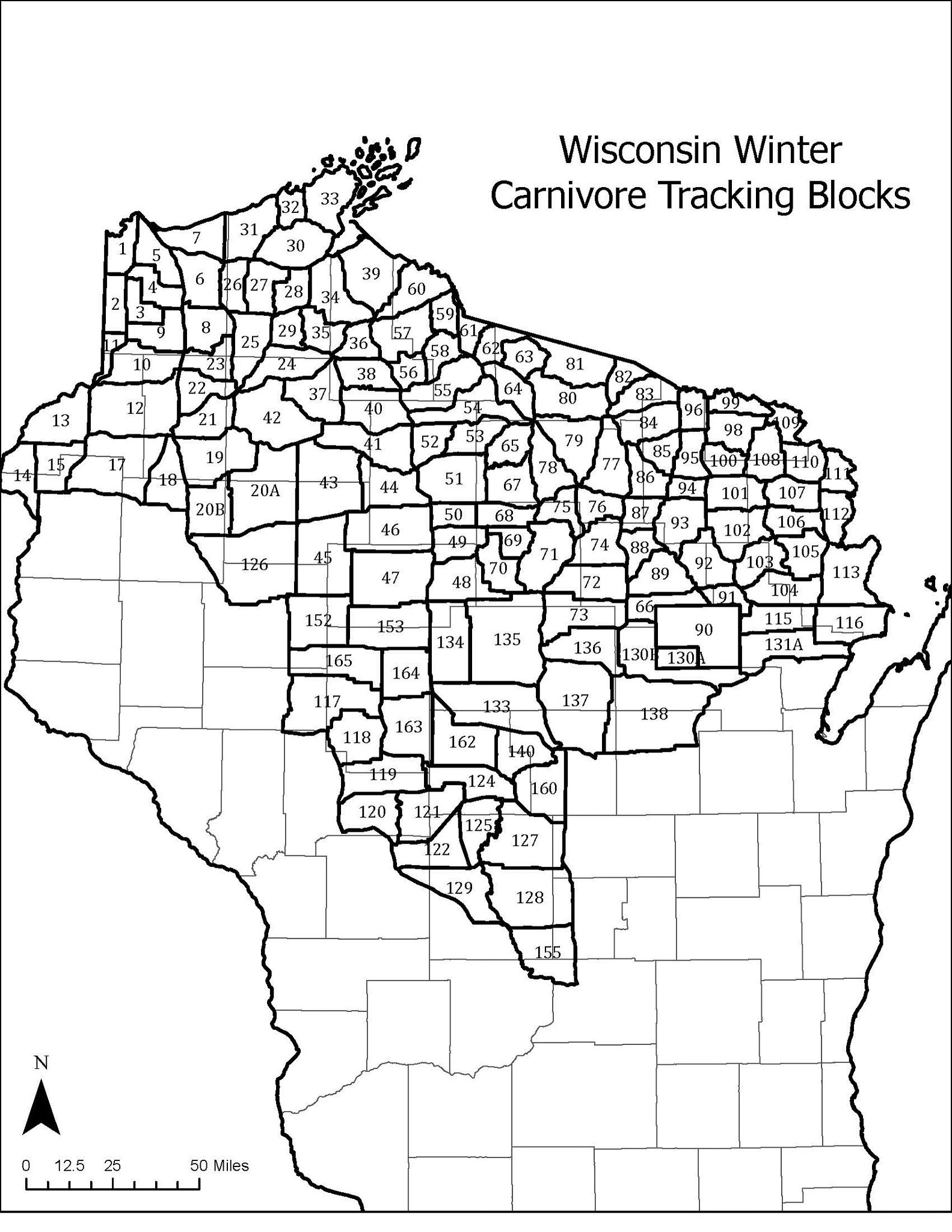
Use the drop-down menu to open a survey block map (PDF).
Carnivore Tracker Forms
Forms are available as online forms or PDFs.
- DNR tracking survey handbook - guidelines and protocols for carnivore tracking.
- Carnivore track survey (1700-052) - use this form to monitor and report carnivore tracking activities for each survey event.
- Carnivore tracking annual survey summary (1700-053) - use this form to summarize and report carnivore tracking activities for the year.
- Wolf track annual survey summary (1700-054) - use this form to report wolf survey summaries for the year.
Become a Tracker
Help monitor Wisconsin's wolf population by conducting winter track surveys!
To participate, you will be expected to:
- Attend a wolf ecology course and track training program sponsored by the DNR, Timber Wolf Alliance, or Timber Wolf Information Network;
- Submit two training surveys prior to first true survey;
- Agree to complete three surveys following DNR guidelines and submit your findings.
Program details, description, schedule, and registration are available here: Carnivore Tracking Program Courses and Registration.
Data from this program is used to supplement DNR surveys and allow the public to be involved in determining the status of our wolf population.
To see the most recent wolf monitoring reports, check out the "Reports" tab above.
For more information on the Volunteer Tracking program, contact: Danielle Deming, Assistant Wolf Specialist.
Wolf Conflicts
Although wolves are a vital part of the ecosystem, conflicts with humans are inevitable, and additional measures to abate damages are sometimes necessary. The DNR collaborates with USDA-APHIS-Wildlife Services to investigate reported conflicts with wolves and implement adaptive abatement measures. Furthermore, the department also offers compensatory reimbursements to those who have experienced verified loss through the Wildlife Damage Program.
What to do if you suspect wolf depredation:
- Immediately contact USDA-Wildlife Services to conduct an investigation. Phone lines are monitored seven days a week, so it is important to leave a message if no one answers the phone;
- Provide as much detail as possible;
- Do not move or unnecessarily handle a carcass;
- Preserve any evidence at the kill site by covering any carcass with a tarp or other covering to discourage scavengers and preserve any tracks, scat, blood or bone fragments;
- Reduce any unnecessary human activity near the depredation site.
Resources
- Current information about dog depredations and caution areas.
- Interactive statewide depredation map.
- Guidance for hunters and pet owners.
- Wolves in Farm Country.
- Sharing the land with wolves.
Advisory Committee
The Wisconsin Wolf Management Plan recommends establishing a new DNR Wolf Advisory Committee. DNR wildlife advisory committees provide input and recommendations to DNR leadership on items such as management plan implementation, policy development and harvest quotas. Wildlife advisory committees also discuss emerging issues related to species management, providing a conduit for public input and increasing transparency of the DNR's conservation activities. By reviewing data and developing recommendations for the DNR's consideration, wildlife advisory committees play a critical role in the adaptive management process even though they are advisory only with no inherent decision-making authority.
Committee Information
The Wolf Advisory Committee is comprised of 24 committee members. Of those members, some are DNR staff and representatives from:
- Invited government agencies/entities
- The Wisconsin Conservation Congress
- Wisconsin’s Ojibwe nations
Ten additional seats are divided amongst five stakeholder categories to ensure a balanced and inclusive representation of stakeholder interests. There is a maximum of two seats per category. Represented interests include:
- Hunting and Trapping
- Agricultural and Ranching
- Environmental
- Conservation Science and Education
- At-Large, Unaffiliated
Stakeholder seats were filled via a competitive application process and are subject to term limits. Review the committee charter to learn more about the committee’s structure and purpose or check out these frequently asked questions.
Membership
In April 2025, DNR opened applications for stakeholder groups and members of the public to form the Wolf Advisory Committee. Applicants were interviewed and selected based on criteria determined by the interview committee. Review the committee roster to learn more about committee members.
Committee Meetings
The committee meets based on the needs of the public. All meetings are publicly noticed on the Hearings and Meetings Calendar page. Meeting minutes can be found on this page as they become available.
Note: To obtain historical DNR wolf advisory committee meeting minutes, email: DNRWildlifeSwitchboard@wisconsin.gov.
Reports
Population
- 2025 Wolf Monitoring Report
- 2024 Wolf Monitoring Report
- 2023 Wolf Monitoring Report
- 2022 Wolf Monitoring Report
- 2021 Wolf Monitoring Report
- 2020 Wolf Monitoring Report
- 2020 Wolf Count Pack Details
- 2019 Wolf Monitoring Report
- 2018 Wolf Monitoring Report
- 2017 Wolf Monitoring Report
To obtain historical monitoring reports, contact Danielle Deming, Assistant Wolf Specialist.
Harvest Season Reports
- Wisconsin Wolf Season Report 2021
- Wisconsin Wolf Season Report 2014
- Wisconsin Wolf Season Report 2013
- Wisconsin Wolf Season Report 2012
Management Plans
- Wisconsin Wolf Management Plan 2023
- Wisconsin Wolf Management Plan (1999, with 2007 addendum)
- USFWS Recovery Plan for the Eastern Timber Wolf (1992)

